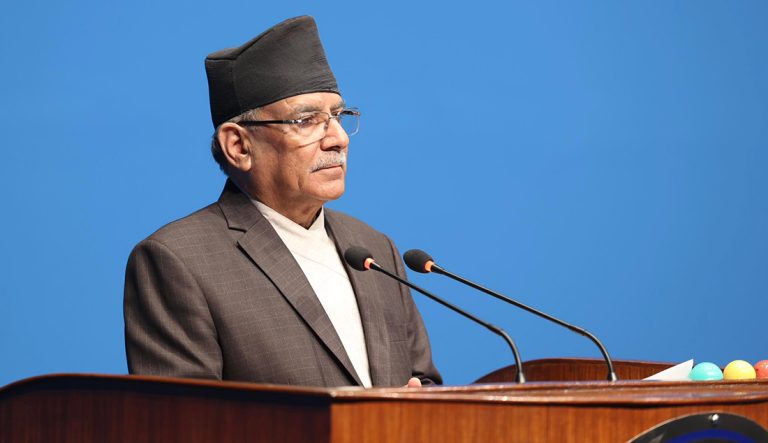Nepal’s political landscape is heating up once again as Prime Minister K.P. Sharma Oli accuses former King Gyanendra Shah of attempting to disrupt social harmony and incite unrest. The comments come after violent pro-monarchy protests erupted in Kathmandu, leaving two people dead and over 100 injured.
Oli Blames Former King for Unrest
Speaking in the House of Representatives on March 31, 2025, Prime Minister Oli stated that the former king was aligning himself with individuals refusing to repay bank loans and stirring social tensions for personal ambitions. His remarks led to an uproar in Parliament, especially from members of the Rastriya Prajatantra Party (RPP), a party advocating for the reinstatement of the Hindu monarchy.
“The alleged organizers attempted to drive a vehicle over the police and breached the restricted area. There were terrorist activities like setting fire to the international airport and the oil corporation’s depot,” Oli claimed. “Setting fire to someone’s house, looting a shopping mall, and burning a herbal company cannot be considered political activities.”
The Prime Minister emphasized that those involved in the violent acts would not be spared and that a full report on the incident would be presented by the Home Ministry in due time.
Protests Turn Violent
Pro-monarchy rallies in Nepal have been gaining traction in recent months. The latest protests turned violent, leading to clashes between security forces and demonstrators. The protests saw over 10,000 people take to the streets, chanting slogans in support of the former king and demanding the return of monarchy.
During the demonstration in Kathmandu’s Tinkune area, two individuals, including a television cameraman, lost their lives. Additionally, 110 people sustained injuries, and over 110 protesters were arrested by security forces.
According to reports, police used tear gas and rubber bullets to disperse the crowd as demonstrators attempted to breach security barriers. The situation escalated when some protesters allegedly set fire to public and private properties, prompting a heavy-handed response from law enforcement.
Former King’s Alleged Role
Prime Minister Oli also accused former King Gyanendra of playing a direct role in encouraging unrest. He alleged that the former monarch had personally invited protest leaders to his residence and appointed a so-called “commander” to lead the movement.
“Former King Shah issued a video statement on Democracy Day (February 19), which incited the crowd. He will not be granted impunity,” Oli declared. “Those seeking to overthrow the system and restore the monarchy must make their views public on these violent actions.”
The Prime Minister also suggested that there had been a deliberate attempt over the past year to manipulate public sentiment by stirring emotions on sensitive issues like religion, culture, and tradition.
RPP Lawmakers Protest in Parliament
Following Oli’s remarks, lawmakers from the Rastriya Prajatantra Party (RPP) strongly objected, staging protests in Parliament. The RPP has been at the forefront of advocating for the restoration of the monarchy, arguing that the country’s current political system has failed to bring stability.
Many Nepalis who once supported democracy have expressed frustration with the current leadership. Corruption, economic struggles, and frequent changes in government have led some to believe that the monarchy could provide a more stable political structure.
“We are here to give the king our full support and to rally behind him all the way to reinstating him in the royal throne,” said Thir Bahadur Bhandari, a protester who participated in recent rallies.
Political Tensions in Nepal
Nepal abolished its monarchy in 2008 following a series of political changes that began with King Gyanendra’s decision to dissolve Parliament and seize absolute power in 2005. This move triggered mass protests, ultimately leading to his downfall. Since then, Nepal has seen 13 different governments in just 17 years, leading to widespread dissatisfaction among the population.
The latest protests reflect growing discontent with Nepal’s political instability. However, despite public support for the monarchy, Gyanendra’s return to power remains highly unlikely. The Constitution of Nepal would need to be amended for a royal reinstatement, and monarchists hold very few seats in Parliament.
Prime Minister Oli has dismissed the idea of a monarchical revival, suggesting that if Gyanendra wishes to lead again, he should contest democratic elections instead. “If he wants to rise to power, let him contest elections in the mountains, hills, or Tarai,” Oli remarked.
While the monarchy’s return seems improbable for now, the increasing number of protests signals deep dissatisfaction with Nepal’s current governance. With political tensions on the rise, the coming months could see further developments as both monarchists and republicans push their respective agendas.


